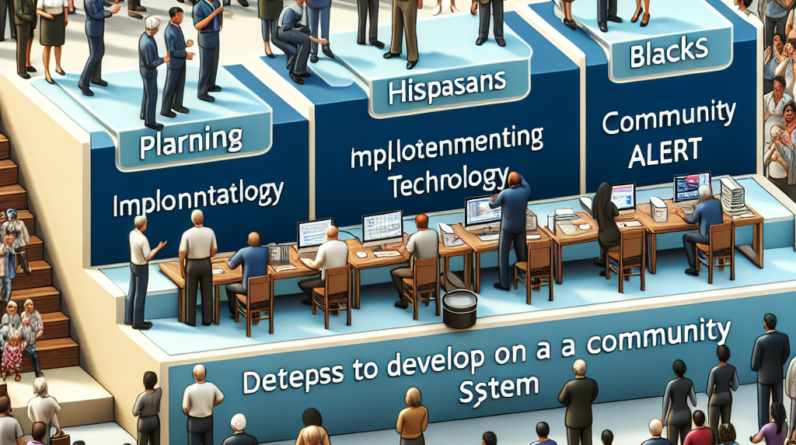
Creating a community alert system can be a pivotal part of ensuring public safety and effective communication within a neighborhood. Every community has unique needs, which makes understanding these needs and setting up a tailored alert system so essential.
Identify the Purpose and Scope of Your Alert System
When planning to establish a community alert system, the initial step is to deeply understand the specific needs of your community. Each area has distinct concerns, whether it’s natural disasters, crime rates, or health advisories. I recall the eye-opening insights gained from discussions with local groups, which highlighted the varied issues different communities face. Once these needs are identified, it’s beneficial to create a prioritized list of potential alerts, as this helps in tailoring the system to what residents value most, such as prioritizing severe weather alerts over local event updates. Engaging the community through surveys or meetings is crucial in developing a system that truly aligns with their concerns, thereby boosting participation rates.
Setting Goals for Your Alert System
After recognizing the community’s requirements, the next step is to establish specific, actionable goals for your alert system. Whether the aim is to decrease emergency response times or enhance communication during crises, setting clear objectives is crucial. It’s useful to define both short-term and long-term goals to monitor progress effectively. Also, consider the scope of your system’s functionality—will it include non-emergency community updates, or strictly urgent alerts? By setting these parameters, you can maintain focus and effectively market the system to residents. This stage is also an opportunity to think creatively about how the alert system could foster broader community engagement beyond its primary function.
Determine Your Communication Channels
Understanding the ‘why’ behind your alert system naturally leads to the ‘how’. In our modern, connected world, selecting appropriate communication channels is vital. This might include SMS, email, social media, or even a dedicated app. A multi-channel approach often proves most effective, allowing you to reach individuals through their preferred mediums. However, it’s important to ensure these channels are accessible to everyone within the community, possibly integrating traditional methods like phone calls alongside newer technologies. Testing these channels through pilot runs can provide invaluable feedback, helping to refine the system before its full rollout.
Build a Network of Stakeholders
A robust community alert system requires the support of local authorities, such as police, fire departments, and government agencies. Early collaboration with these entities not only secures their backing but also offers additional insights into the types of alerts most pertinent to issue. Regular interactions with these stakeholders can facilitate smooth information flow and enhance cooperation, which is beneficial for the community. Moreover, don’t hesitate to seek out resources or support from these authorities; many have access to funds or tools that could enhance your system’s capabilities.
Including community organizations in the development and dissemination of your alert system can significantly extend its reach and effectiveness. Partnerships with neighborhood associations and educational institutions can promote system adoption and trust within the community. Clearly defining the roles these organizations will play and establishing formal agreements are key to maintaining structured and effective collaboration.
Foster Community Involvement
The success of an alert system is greatly enhanced by active community involvement. Encouraging local residents to participate in the system’s creation and upkeep instills a sense of ownership and commitment. Organizing workshops and training sessions not only educates but also empowers community members to effectively use the system. Additionally, implementing a mechanism for feedback allows the system to evolve in response to the community’s experiences and needs, further demonstrating your commitment to their well-being.
Develop Alert Protocols
With the foundational elements in place, the next step involves establishing clear guidelines for issuing alerts. This includes creating standardized templates for various types of notifications to ensure clarity and consistency in communications. Using straightforward language and including essential details like the nature of the alert, its importance, and advised actions can significantly aid in effective communication during critical times. Regular updates to these protocols ensure they remain relevant and effective as local conditions and technologies evolve.
Test Your System Regularly
Before officially launching, thorough testing of the alert system is essential. Conducting regular drills helps identify any operational gaps and ensures that all participants are clear on their roles. Involving community members in these tests not only refines the system but also builds trust and confidence in the measures being implemented. Tracking and analyzing the outcomes of these tests enables ongoing improvements, making the system more robust over time.
Provide Training for Users
Effective operation of the alert system depends heavily on the training provided to its users. Regular, comprehensive training sessions should be held to ensure everyone involved is proficient in using the system and understands the established protocols. Offering training in various formats—such as videos, live demonstrations, and hands-on practice—can cater to different learning preferences and help in retaining crucial information. Ongoing training sessions are necessary to accommodate new volunteers and refresh the knowledge of existing participants.
Promote Your Community Alert System
Once your system is in place, it’s important to raise awareness about it. Utilizing social media effectively can engage the community and keep them informed about the system’s benefits and how to participate. Hosting community events provides a platform for direct interaction, allowing residents to learn about the system in an engaging and hands-on manner. Collaborating with local media to cover these events can further amplify your message and enhance the system’s visibility within the community.
FAQ
1. What are the first steps to create a community alert system?
Start by identifying the specific needs of your community, set clear goals for what you want to achieve, and determine the best communication channels to reach residents. Gathering input from community members is crucial in this early stage.
2. How can I engage local authorities in my alert system?
Building relationships with local authorities is essential. Start by reaching out to them to communicate your intent and ideas. Offer to collaborate on how the alert system can best serve the community, which will help secure their support.
3. What communication channels are most effective?
A multi-channel approach tends to work best. Consider using SMS, emails, social media platforms, and even a community app to ensure you reach as many residents as possible, accommodating your community’s varying tech preferences.
4. How do I promote my alert system effectively?
Leverage social media to spread awareness, host community events that explain the system, and collaborate with local media to get the word out. Connecting with residents directly breeds trust and participation.
5. How often should I test the alert system?
Regular testing is crucial! I recommend conducting drills at least twice a year and providing continuous training to ensure everyone involved is familiar with their roles and the system’s operations.




